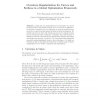Free Online Productivity Tools
i2Speak
i2Symbol
i2OCR
iTex2Img
iWeb2Print
iWeb2Shot
i2Type
iPdf2Split
iPdf2Merge
i2Bopomofo
i2Arabic
i2Style
i2Image
i2PDF
iLatex2Rtf
Sci2ools
239
Voted
EMMCVPR
2011
Springer
2011
Springer
Curvature Regularization for Curves and Surfaces in a Global Optimization Framework
Length and area regularization are commonplace for inverse problems today. It has however turned out to be much more difficult to incorporate a curvature prior. In this paper we propose several improvements to a recently proposed framework based on global optimization. We identify and solve an issue with extraneous arcs in the original formulation by introducing region consistency constraints. The mesh geometry is analyzed both from a theoretical and experimental viewpoint and hexagonal meshes are shown to be superior. We demonstrate that adaptively generated meshes significantly improve the performance. Our final contribution is that we generalize the framework to handle mean curvature regularization for 3D surface completion and segmentation. 1 Curvature in Vision The problem we are interested in solving amounts to minimizing the following energy functional: E(R) = R g(x) dx + ∂R λ + γκ(x)2 dA(x), (1) where R is the 2D (or 3D) foreground region with boundary ∂R. Here g(x) is...
Related Content
| Added | 20 Dec 2011 |
| Updated | 20 Dec 2011 |
| Type | Journal |
| Year | 2011 |
| Where | EMMCVPR |
| Authors | Petter Strandmark, Fredrik Kahl |
Comments (0)

